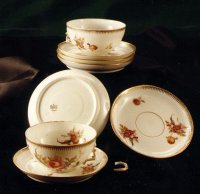
Manufacturer: Limoges Porcelain:
Sazerat, L., Mark 1, underglaze white ware Mark in green with, "France" (c. after 1891-late 1890's
Manufacturer: Limoges Porcelain: Sazerat, L., Mark 1, underglaze white ware Mark in green with, "France" (c. after 1891-late 1890's![]()

![]()
![]() Leon Sazerat began his career in the Limoges porcelain industry during the 1850's. He was associated with Blondeau from the early 1880's.
Leon Sazerat began his career in the Limoges porcelain industry during the 1850's. He was associated with Blondeau from the early 1880's.
![]() Mark 1 is found on white ware, this mark seems to reflect the time of the company after Sazerat's death, in 1891.
Mark 1 is found on white ware, this mark seems to reflect the time of the company after Sazerat's death, in 1891.
Limoges Porcelain:
![]() Limoges Porcelain is a hard paste porcelain. Limoges is the city where factories producing this type of porcelain have been located for a little over 200 years. The name of the city has in fact become synonymous with the high quality products manufactured by those companies. The Limousine region of France seemed predestined to be the home for the arts of fine porcelain. This occurred because the surrounding area of Limoges is rich in deposits of kaolin and feldspar, the essential ingredients for natural, or hard pastes porcelain. The city of Limoges is located about 200 miles south of Paris in the region known as Haute Vienne.
Limoges Porcelain is a hard paste porcelain. Limoges is the city where factories producing this type of porcelain have been located for a little over 200 years. The name of the city has in fact become synonymous with the high quality products manufactured by those companies. The Limousine region of France seemed predestined to be the home for the arts of fine porcelain. This occurred because the surrounding area of Limoges is rich in deposits of kaolin and feldspar, the essential ingredients for natural, or hard pastes porcelain. The city of Limoges is located about 200 miles south of Paris in the region known as Haute Vienne.
Methods:
![]() If mark contains name of the country of origin, the piece was made after 1891.(Mckinley Tariff Law).
If mark contains name of the country of origin, the piece was made after 1891.(Mckinley Tariff Law).
![]() If the mark has the word "France" it was made after 1891.
If the mark has the word "France" it was made after 1891.
![]() Transfer and mixed medium used most frequently for table china (1870-1920's)
Transfer and mixed medium used most frequently for table china (1870-1920's)
![]() The style of the early decoration of Limoges porcelain consisted largely of gold designs of themes of flowers and people.
The style of the early decoration of Limoges porcelain consisted largely of gold designs of themes of flowers and people.
![]() Table china is more likely to be decorated in delicate styles. Gold trim is the second chief characteristic of Limoges porcelain. The gold is referred to as coin gold was added to Limoges during the height of the Limoges period.
Table china is more likely to be decorated in delicate styles. Gold trim is the second chief characteristic of Limoges porcelain. The gold is referred to as coin gold was added to Limoges during the height of the Limoges period.
Source:
Items in Point Ellice House Collection:
Object Name: Set, Tea (picture above)Accession Number: 1975.0001.0212. A-AK
Object Name: teapot (picture below)Accession Number: 1975.0001.0346
